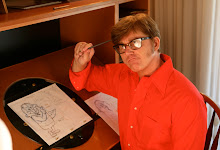 When you see a whole scene like this, it's so filled with detail and information that it's hard to know where to start.
When you see a whole scene like this, it's so filled with detail and information that it's hard to know where to start. I'll try to analyze what makes a tree recognizeable:
I'll try to analyze what makes a tree recognizeable:1) its overall shape
2) the pattern or structure of its branches and leaves - now I can see this in the picture above, but I don't know how to put it into words or even form a mental picture of its general form. Aaargh!
here are my first scratchy quick studies of random stuff outta the book.
 I tried to get simple structures that looked like the trees without having every leaf drawn. It's not easy. I want to find cartoony ways to stylize the shapes and patterns that look fun and confident. I sure am not there yet.
I tried to get simple structures that looked like the trees without having every leaf drawn. It's not easy. I want to find cartoony ways to stylize the shapes and patterns that look fun and confident. I sure am not there yet. I couldn't resist drawing that crawfish and the kid around it. It's an interesting bunch of angles, and not what you usually see in a cartoon because of the difficult point of view.
I couldn't resist drawing that crawfish and the kid around it. It's an interesting bunch of angles, and not what you usually see in a cartoon because of the difficult point of view.
 I like these flowers a lot. They look simple on the surface:
I like these flowers a lot. They look simple on the surface:1) They have an easy to see overall form-long s curved frond shapes.
2) They have a pattern of details that follow the frond shape.
The pattern is made of the rows of flowers that are neatly lined up perpendicular to the waving stem.
I see it easily, but it's another thing to try and draw it so it looks good.
 I gave up on that one.
I gave up on that one. Here's a nice winter scene that has some trees that have very bold shapes.
Here's a nice winter scene that has some trees that have very bold shapes.Their patterns and textures are much harder to decipher.

I made a mess of the composition and evened out all the sizes. It's very frustrating that I can feel the way the needles on the tree branch out and are weighed down by the snow. They are definitely making a very noticeable general pattern, but I can't figure out how to translate it.
 I would suggest to everyone to not neglect how things other than characters look. If you have a park nearby or scenic area, grab your pads and get out there and do some sketches. Squint your eyes when you look at the scenes and try to decipher the overall big shapes and forms first. Then fill them in with descending levels of patterns.
I would suggest to everyone to not neglect how things other than characters look. If you have a park nearby or scenic area, grab your pads and get out there and do some sketches. Squint your eyes when you look at the scenes and try to decipher the overall big shapes and forms first. Then fill them in with descending levels of patterns.Try to notice the different shapes that different species of trees take. Many cartoonists like me have stock cartoon trees in our heads and we just draw the same one over and over again, which is lazy and boring.
The world is full of visual interest that can be cartooned. Get out there and look at it. Don't just learn what a tree and a cloud looks like from the comics. There's more variety in real life.

No comments:
Post a Comment
Note: Only a member of this blog may post a comment.